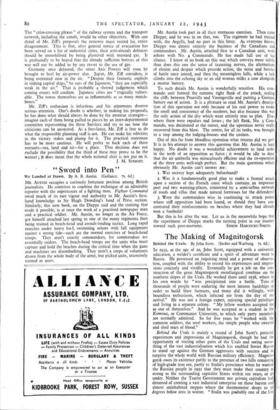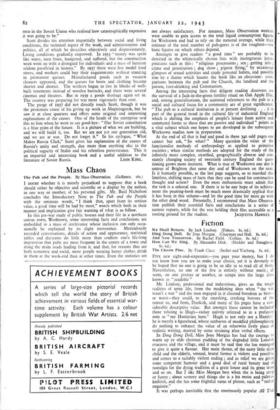The Making of Magnitogorsk
Behind the Urals. By John Scott. (Seeker and Warburg. 7s. 6d.) IN 1932, at the age of 20, John Scott, equipped with a university education, a welder's certificate and a spirit of adventure went to Russia. He possessed an inquiring mind and a power of observa- tion, coupled with the ability to record his experiences and impres- sions concisely and vividly. Eventually he got a job on the con- struction of the great Magnitogorsk metallurgical combine on the southern slopes of the Urals. He worked there until 1938, where in his own words he "was precipitated into a battle. Tens of thousands of people were enduring the most intense hardships in order to build blast furnaces, and many did it willingly, with boundless enthusiasm, which infected me from the day of my arrival." He was not a foreign expert, enjoying special privileges and living in a separate colony. " My fellow workers accepted me as one of themselves." And he was accepted as a student in the Komvuz, or Communist University, to which only party members are normally admitted. So for five years he " worked with the common soldiers, the steel workers, the simple people who sweated and shed tears of blood."
Behind the Urals is mainly a record of John Scott's personal experiences and impressions of Magnitogorsk, though he had the opportunity of visiting other parts of the Urals and seeing some- thing of the vast industrialisation which has enabled Soviet Russia to stand up against the German aggressors with success and to surprise the whole world with Russian military efficiency. Magnito- gorsk owes its existence partly to the presence of two hills consisting of high-grade iron ore, partly to Stalin's prescience when he warned the Russian people in 1931 that they must make their country as strong as the surrounding capitalist States within ten years, or go under. Neither the Tsarist Government nor private; capitalists had dreamed of creating a vast industrial enterprise on those barren and almost uninhabited steppes where the thermometer drops to 50 degrees below zero in winter. " Stalin was probably one of the fe
men in the Soviet Union who realised how catastrophically expensive it was going to be." Scott divides his attention impartially between social and living conditions, the technical aspect of the work, and administration and politics, all of which he describes objectively and dispassionately. Living conditions gradually improved. In 1933 " money was spent like water, men froze, hungered, and suffered, but the construction work went on with a disregard for individuals and a mass of heroism seldom paralleled in history." By 1937 there were five model food stores, and workers could buy their requirements without standing in permanent queues. Manufactured goods such as vacuum cleaners appeared, and the queues for boots and clothing became shorter and shorter. The workers began to live in blocks of well- built tenements instead of wooden barracks, and there were several cinemas and theatres. But in 1939 a goods shortage again set in. The country was preparing for war more vigorously than ever.
The purge of 1937 did not directly touch Scott, though it was the proximate cause of his giving up work in Magnitogorsk, but he saw it at close quarters and offers some original and interesting explanations of the causes. One of the heads of the enterprise said this to him when he went to say good-bye : " Our Soviet constitution is a blue print of the future. It is a picture of what we arc building, and we will build it, too. But we are not yet one generation old, and we are at war. Do not forget it." In his epilogue, " What Makes Russia Click," Scott gives his explanation of the causes of Russia's unity and strength, due more than anything else to the political sagacity of Stalin and his relentless perseverance.' This is an impartial and interesting book and a useful addition to the



























 Previous page
Previous page